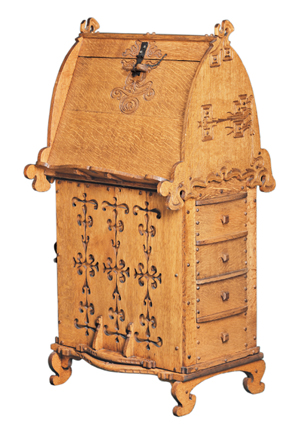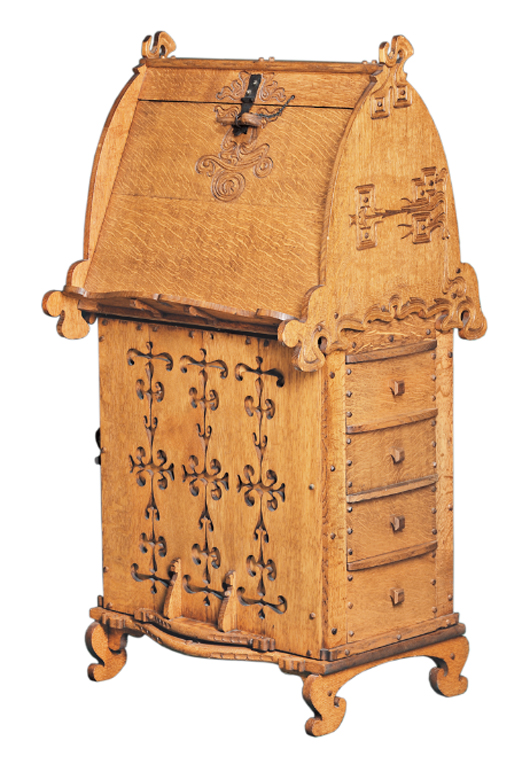
Arts and Crafts, or Mission, furniture is described in most catalogs and books as functional and simple, with straight legs and arms. Pieces have little decoration, just visible mortise-and-tenon joints. Light or dark oak was preferred. It was a short-lived style popular from 1900 to about 1915.
The designs were a revolt against the curved, highly decorated furniture of Victorian times. They echoed the English William Morris and John Ruskin idealized view of the single workman creating a piece of furniture in an honest, personal manner. Morris and Ruskin liked the medieval craft guild organization, although they misinterpreted it to be one man, one object. Studies today show that for centuries a single piece of furniture might have been made by many different expert craftsmen who were carvers, turners, designers or specialists who created parts of a chair or chest.
The revival of the Arts and Crafts style in the 1980s has lasted longer than the workshops of Gustav Stickley, Roycroft and other Mission makers.
Charles Rohlfs, who is often listed with these makers, was a New York City furniture maker who worked during the years Arts and Crafts ideas were popular, but he had his own ideas and designs. He used curves and cutouts, high backs on chairs and strange feet. His furniture did not fit in with the look expected then or during the 1980s revival, so until recently it was rarely offered at large auctions and shows. But new research about Rohlfs and new respect for his work should lead to more collector interest and higher prices.
Q: I would like information about a metal bank I have that’s a replica of a water heater. It has a metal plate on the front that reads, “Rex, The Cleveland Heater Co., Cleveland, Ohio.” It’s 7 3/4 inches tall and has a coin slot in the top. I have had this bank since the late 1930s or early ’40s. Is it valuable or collectible?
A: An ad for Rex water heaters that appeared in a 1959 issue of Popular Mechanics stated that the Cleveland Heater Co. had been in business for more than 50 years, so the company was probably founded in about 1908. It was sold to M.M. Hedges Manufacturing Co. of Chattanooga, Tenn., on Nov. 5, 1963, and all the manufacturing operations were moved to Tennessee. Interesting or unusual advertising items attract the attention of collectors. A bank like yours sold at auction in 2010 for $453, and another sold on eBay for a very low price.
Q: I have a Post Cereal Roy Rogers “pop-out card.” It’s No. 10 in a series of 36 and pictures Roy and his dog, Bullet. What year were these printed? Does it have any value?
A: Roy Rogers was born Leonard Franklin Slye in Cincinnati in 1911. His family moved to Los Angeles in 1930 and Roy was discovered after singing in an amateur night. He began his acting career using the name Dick Weston and didn’t use the name Roy Rogers until 1938. Republic Studios wanted him to use the name Leroy Rogers, but Roy didn’t like the name Leroy, so he chose Roy. Post Cereals “pop-out” cards were enclosed in several varieties of Post cereals in 1952. Part of the picture was cut so that it would pop out from the background when the picture was folded correctly. The back of each card listed the number of the card, title and description. A single card is worth about $10-$15. A complete set of 36 cards in great condition has sold for $800.
Q: Could there really be a company called Carl Schneider’s Heirs? I have a bisque figure of a young girl and my mother says that is the maker’s name. I think it must be the name of the person who gave it to Grandma.
A: It is a strange name, yet there was such a company, no doubt the heirs Carl Schneider named in his will. The name in German is Carl Schneider’s Erben. Schneider was part of Unger, Schnieder & Cie (company), a factory that made porcelalin, figurines, doll heads, religious items and household dishes from 1861 to 1887 in Thuringia, Germany. The company closed in 1887 and went to the heirs. The heirs’ company seems to have closed in about 1972.
Q: We were given a picture titled Deer in Repose, A View in the Isle of Arran, painted by R. Cleminson, Engraved by George Zobel, published by L. Brall & Sons. It has some brown streaks and spots on it. It’s in a huge wooden frame that’s boarded up in the back. Friends tell me that I should be present when it’s appraised because people often hide things of value behind the boards. Is this worth having appraised?
A: Robert Cleminson was a British artist active from 1865 to 1868 who specialized in “sporting” art, paintings of Highland scenes of dogs, deer, game and other animals. The streaks in the picture are a type of mold called “foxing” and are expensive to remove. Cleminson prints in good condition sell for under $100. Prints in poor condition don’t sell. Your print is worth less than its frame. You rarely find things hidden behind backing boards. Sometimes you find things behind the paper dust covering.
Tip: Don’t lock furniture with antique locks. If they stick, it’s almost impossible to open the door or drawer without damaging the wood.
Need prices for collectibles? Find them at Kovels.com, our website for collectors. More than 84,000 prices and 5,000 color pictures have just been added. Now you can find more than 900,000 prices that can help you determine the value of your collectible. Access to the prices is free at Kovels.com/priceguide.
Terry Kovel answers as many questions as possible through the column. By sending a letter with a question, you give full permission for use in the column or any other Kovel forum. Names, addresses or email addresses will not be published. We cannot guarantee the return of any photograph, but if a stamped envelope is included, we will try. The volume of mail makes personal answers or appraisals impossible. Write to Kovels, Auction Central News, King Features Syndicate, 300 W. 57th St., New York, NY 10019.
CURRENT PRICES
Current prices are recorded from antiques shows, flea markets, sales and auctions throughout the United States. Prices vary in different locations because of local economic conditions.
- Cookbook, Through the Menu with Jell-O, pictures of entrees, appetizers & salads, copyright 1927, Jell-O, Inc., 4 x 5 3/4 inches, $20.
- Brass bedroom door knocker, impressed “Esmeralda,” crinoline dress, holding parasol, tree in background, marked, 1920s, 3 1/2 inches, $60.
- Baby Smile’n Frown doll, vinyl, smiles when her left hand is raised, pouts when hand is lowered, plastic teardrops, blond hair, blue eyes, Mattel, 1965, 9 1/2 inches, $65.
- Tom Mix Spinning Rope lasso, Ralston Cereal Straight Shooters Club premium, 1935, 88 inches, $125.
- Beswick Old English Sheepdog figurine, No. 2232, glossy white and gray, black eyes, protruding pink tongue, stamped, 1970s, 11 1/2 inches, $250.
- Whiting and Davis mesh bag, Chinese lantern shape, four layers, one each for mirror, powder, money and hanky, floral decoration, four royal blue rhinestones, 1920s, 4 inches, $425.
- China cabinet, mahogany, double glass doors with five panes of glass, two glass shelves, Queen Anne legs, scalloped brackets, England, 1920s, 42 x 49 inches, $745.
- Walt Disney toy train set, Meteor Express, tin lithograph windup, train platform with Walt Disney characters, Marx, box, 1949, $950.
- Piano shawl, embroidered Cantonese silk, flowers, birds flying and sitting on branches, pagodas, ducks, white fringe, circa 1920, 49-inch square, $1,450.
- Coca-Cola pocket mirror, celluloid, woman in black bathing suit standing by red umbrella holding bottle of Coke, 1922, 2 3/4 x 1 3/4 inches, $2,860.
Available now. The best book to own if you want to buy or sell or collect – and if you order now, you’ll receive a copy with the author’s autograph. The new Kovels’ Antiques & Collectibles Price Guide, 2012, 44th edition, is your most accurate source for current prices. This large-size paperback has more than 2,500 color photographs and 40,000 up-to-date prices for more than 775 categories of antiques and collectibles. You’ll also find hundreds of factory histories and marks, a report on the record prices of the year, plus helpful sidebars and tips about buying, selling, collecting and preserving your treasures. Available online at Kovelsonlinestore.com; by phone at 800-303-1996; at your bookstore; or send $27.95 plus $4.95 postage to Price Book, Box 22900, Beachwood, OH 44122.
© 2012 by Cowles Syndicate Inc.
ADDITIONAL IMAGE OF NOTE



